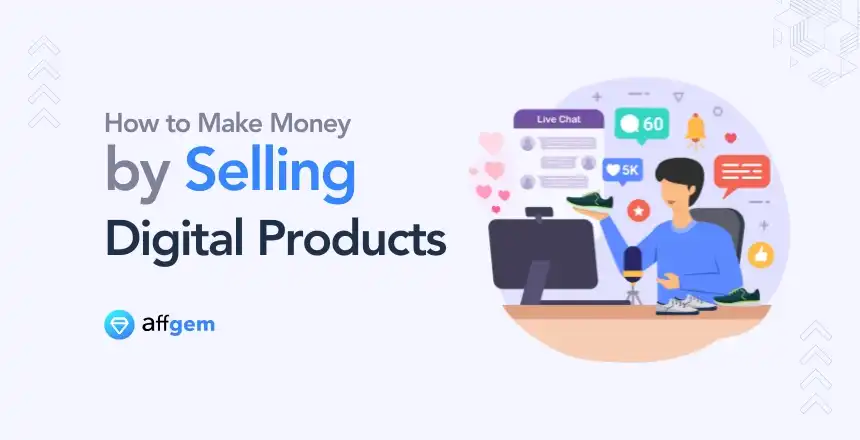In 2025, the digital product market is experiencing remarkable growth, offering entrepreneurs unprecedented opportunities to generate income online. Digital products—intangible items like eBooks, online courses, software, and templates—have become increasingly popular due to their low production costs and global reach.
Notably, the e-learning industry alone is projected to be worth $165 billion this year. This surge in demand presents a lucrative avenue for individuals looking for making money by selling digital products.
Selling digital products not only eliminates the need for inventory management and shipping logistics but also allows for automation, enabling entrepreneurs to earn passive income. With minimal overhead costs, the potential for profit is substantial.
Platforms such as Thinkific highlight the vast array of digital products that can be monetized, including online courses, eBooks, and various downloadable resources. This guide delves into the strategies and opportunities available for teaching you how to start selling digital products.
What Are Digital Products?
Digital products are intangible goods that are created, distributed, and consumed electronically. Unlike physical products, they do not require manufacturing, inventory storage, or shipping, making them an ideal option for online businesses.
These products can be easily sold and delivered to customers worldwide, often providing a passive income stream once the product is created – yes – making money by selling digital products is possible.
In 2025, the market for digital products continues to expand, offering endless opportunities for entrepreneurs, helping them in making money by selling digital products. The types of digital products to sell are diverse, allowing sellers to choose from a wide range of options based on their expertise and audience, and also aiding in.
Why Sell Digital Products in 2025?

Selling digital products in 2025 is an excellent opportunity for entrepreneurs due to the rapid growth of online businesses and the many advantages digital products offer. Here are five key reasons why you should consider making money by selling digital products:
1. Explosive Growth of Online Businesses
The online business sector is booming, with more consumers than ever turning to the internet for convenience. This growth includes digital products, creating a huge opportunity to tap into a global market.
2. Ease of Distribution
Digital products can be delivered instantly to customers worldwide with minimal effort. There’s no need for inventory, warehousing, or shipping—just a website and payment processor, and you’re ready to go, therefore making money by selling digital products is the easiest to do.
3. Low Overhead Costs
Selling digital products eliminates production, shipping, and storage costs, leaving you with a much higher profit margin. After the initial creation, distribution costs are minimal, making it a highly efficient business model, and as a result, making money by selling digital products becomes quicker.
4. Scalability
Digital products are easy to scale. Once created, they can be sold to unlimited customers without additional effort, allowing your business to grow rapidly without increasing operational costs, and you will see yourself making money by selling digital products in no time.
5. Global Reach and Flexibility
Selling digital products opens up a global market, enabling you to reach customers anywhere in the world. Plus, you can sell products 24/7, offering flexibility in both pricing and timing.
Selling digital products in 2025 offers unparalleled advantages, from low overhead to massive scalability, making it an ideal way to build a profitable online business.
Top Digital Products to Sell in 2025
As the digital product market continues to grow in 2025, there are a variety of profitable products that entrepreneurs can create and sell. Here are some of the best digital products to sell this year:
1. eBooks

eBooks remain one of the most popular digital products due to their simplicity and wide appeal.
Whether you’re writing fiction, guides, or how-to manuals, eBooks can be easily created and sold through platforms like Amazon Kindle or your own website. They are a great way to share your knowledge or creativity and generate income.
2. Online Courses

The demand for online learning is skyrocketing, making online courses a top digital product in 2025.
Whether it’s a course on business skills, health and fitness, or creative arts, you can monetize your expertise through platforms like Teachable or Thinkific. Online courses are ideal for those looking to teach a niche subject and scale their business.
3. Software and Apps

Developing software or mobile applications is a highly profitable way to sell digital products. From productivity tools to entertainment apps, the possibilities are vast.
The global app economy continues to grow, providing a lucrative market for developers with technical expertise.
4. Stock Photos and Graphics

Photographers and graphic designers can sell high-quality images, illustrations, and design assets to a global market.
Stock photos and graphics are always in demand for websites, advertisements, and content creation, with platforms like Shutterstock and Etsy providing exposure to potential buyers.
5. Printables (Calendars, Planners, etc.)

Printables, such as planners, calendars, worksheets, and templates, are an easy-to-create digital product that’s always in demand. They cater to niche audiences interested in organization, productivity, and self-improvement.
Selling printables on platforms like Etsy can lead to consistent income with low production costs. Sellling digital planners is one of the easiest things to do.
6. Digital Art & NFTs

Digital art continues to thrive in 2025, especially with the rise of NFTs (Non-Fungible Tokens). Artists can create unique digital artwork or collectibles and sell them as NFTs through marketplaces like OpenSea or Rarible.
This trend has created new income streams for digital artists looking to monetize their creativity in innovative ways.
How to Create and Sell High-Quality Digital Products for Profit
Creating high-quality digital products involves a series of well-planned steps, from brainstorming to production. By following this structured approach, you can ensure that your digital product is not only valuable to your audience but also professional and market-ready. Here’s a step-by-step guide on how to create digital products:
1. Brainstorming and Ideation
Start by identifying your target audience and understanding their needs. Research current market trends and what products are in demand.
Brainstorm ideas for a digital product that can solve a problem or provide value, whether it’s an eBook, online course, software, or any other digital asset. This stage is crucial for defining the core value of your product.
2. Planning
Once you have an idea, outline your product’s structure and content. For example, if you’re creating an online course, plan your curriculum, modules, and lessons.
If you’re designing a digital template, plan the layout, features, and usability. Mapping out the project helps you stay organized and ensures all essential components are included.
3. Designing
The design of your digital product is vital to its success, especially if it’s something visual like an eBook, printable, or digital art.
Use graphic design tools to create professional-looking visuals that enhance the user experience. For courses, consider creating engaging slides, videos, or interactive elements to keep learners engaged.
- Tools for Design:
- Canva – Great for creating eBooks, printables, and graphics.
- Adobe Creative Suite – Ideal for more advanced design needs, including illustrations and video editing.
- Figma – Useful for designing user interfaces or prototypes for apps.
4. Production
This is where you bring your digital product to life. For eBooks, this means formatting your content into a downloadable file (PDF, ePub, etc.).
For online courses, it means recording videos, uploading them to your course platform, and adding assessments or interactive components. If creating software or apps, this stage involves coding and developing the final product.
- Tools for Production:
- Thinkific or Teachable – For creating and hosting online courses.
- Scrivener – For writing and formatting eBooks.
- WordPress + WooCommerce – For selling digital products like templates, guides, and designs.
5. Testing and Refining
Before launching your digital product, thoroughly test it to ensure it works as intended. If it’s a software product, test for bugs.
If it’s a course, make sure all the lessons are accessible and engaging. Collect feedback from beta testers or potential users to identify any areas for improvement.
6. Finalizing and Launching
Once you’re satisfied with the quality of your product, it’s time to prepare for launch. Ensure your product is accessible for download or purchase, create a compelling sales page, and plan your marketing strategy. Set up payment gateways and delivery systems to make the process smooth for customers.
- Tools for Launching:
- Shopify or Gumroad – For selling and delivering digital products.
- Mailchimp or ConvertKit – For email marketing campaigns.
By following these steps, you can ensure you’re creating high-quality digital products that will meet the needs of your audience and help you succeed in the competitive online marketplace.
Setting Up Your Online Store to Sell Digital Products
To successfully sell digital products online, choosing the right platform and optimizing your store for a great user experience is key. Here’s how to set up an effective digital product store:
1. Choosing the Right Platform
Several platforms cater to selling digital products, each with unique features:
- Shopify: Great for customizable digital storefronts and comprehensive e-commerce tools.
- Etsy: Ideal for selling digital art, printables, and templates with a built-in audience.
- Gumroad: Simple platform for selling eBooks, courses, and digital files with minimal setup.
- Teachable: Best for selling online courses with features for course creation and sales management.
- Sellfy: Easy-to-use platform for selling digital and physical products, including subscriptions.
2. Optimizing for User Experience and Conversions
- Professional Design: Keep your store layout clean, easy to navigate, and visually appealing.
- Clear Call-to-Actions (CTAs): Make purchase buttons like “Buy Now” or “Download” easy to find.
- Multiple Payment Options: Offer various payment methods, such as PayPal and credit cards, to accommodate different preferences.
- Mobile Optimization: Ensure your store is mobile-friendly, as many customers shop from their phones.
3. Implementing SEO Strategies
To boost visibility, use relevant keywords in your product titles, descriptions, and meta tags. Creating blog content around your digital products can also help improve your store’s SEO and drive organic traffic.
By selecting the right platform and optimizing your store, you can create a seamless shopping experience that increases conversions and drives sales for your digital products.
How to Market Your Digital Products
Marketing your digital products is crucial to building visibility and increasing sales. Here’s how to effectively promote your products with a focus on SEO, social media, influencer marketing, and email strategies:
1. SEO Strategies for Digital Products

To drive organic traffic to your digital products, optimize your website and product pages with relevant keywords. Focus on:
- Keyword Optimization: Use keywords like “how to market digital products” in your titles, descriptions, and meta tags.
- Content Marketing: Create valuable content (blog posts, guides, videos) that aligns with your products, boosting SEO and driving traffic.
- Backlinks: Build backlinks by guest posting or collaborating with other content creators in your niche to increase your site’s authority.
2. Social Media Marketing

Social media platforms are powerful tools for promoting digital products. Platforms like Instagram, Pinterest, and TikTok allow you to visually showcase your products and engage with your audience.
Post regular updates, share behind-the-scenes content, and use hashtags to reach a wider audience. Run ads targeting specific demographics to increase your product visibility. These tips and tricks will surely help you in making money by selling digital products.
3. Influencer Marketing and Partnerships

Partner with influencers or content creators in your niche to help promote your digital products. Influencers can create authentic content that resonates with their audience and drives traffic to your product pages.
Look for influencers with engaged followers who align with your target market, that is important when you are looking at making money by selling digital products.
4. Email Marketing for Digital Product Sales

Email marketing is one of the most effective tools for selling digital products online. Start by building an email list with lead magnets like free eBooks or downloadable templates. Send targeted emails to your list with exclusive offers, new product launches, and helpful content to nurture your subscribers and encourage sales.
By combining these strategies—SEO, social media marketing, influencer partnerships, and email marketing—you can successfully market your digital products and reach a broader audience in 2025. Email marketing is the cheapest way to assist you in making money by selling digital products.
Pricing Your Digital Products for Maximum Profit
Pricing your digital products effectively is key to maximizing your profits. Here are the best strategies to consider:
1. Market Research

Research your competitors and the market to understand standard pricing for similar products. This helps you set a competitive yet profitable price based on the quality and value of your product.
Without market research, it is impossible for you to proceed with making money by selling digital products.
2. Value-Based Pricing

Price your product based on the value it provides to customers, not just production costs. If your product solves a specific problem or offers high benefits, you can justify a higher price.
How will you learn the basics of making money by selling digital products unless you master the art of value-based pricing?
3. Competitive Pricing

Check what your competitors charge and aim to align with industry standards while considering your product’s unique features.
Price too high and you may lose customers, too low and you’ll hurt profits. This is a key aspect when you are learning about making money by selling digital products.
4. Bundles or Subscriptions

Offer bundles of related products at a discounted rate or create subscription models where customers pay for ongoing access to new products. This increases both sales and customer loyalty.
By using these pricing strategies—market research, value-based pricing, competitive pricing, and bundles or subscriptions—you can maximize profits while ensuring your digital products are priced effectively. This is very important when you are thinking of making money by selling digital products.
Common Mistakes to Avoid When Selling Digital Products
Selling digital products can be highly profitable, but there are several common mistakes that can hinder your success. Avoiding these pitfalls will help you build a more sustainable and profitable business.
Here are some common mistakes when selling digital products which can hamper your goal of making money by selling digital products and tips on how to avoid them:
1. Poor Product Quality
One of the biggest mistakes is selling a low-quality digital product. Whether it’s an eBook, online course, or software, your product should provide real value to your customers.
To avoid this mistake, thoroughly test your product, ensure it meets high standards, and gather feedback from early users to improve it before launching.
2. Not Optimizing for SEO
If your website isn’t optimized for search engines, you’re missing out on organic traffic which may hamper your goal of making money by selling digital products.
Poor SEO can make it difficult for potential customers to find your products. To avoid this, use keyword optimization, create high-quality content, and focus on building backlinks to improve your search engine ranking.
3. Neglecting Customer Support
Customer support is often overlooked when selling digital products, but it’s essential for building trust and loyalty. Failing to offer timely assistance can lead to frustration and negative reviews.
Ensure you have a clear support system in place, such as email or live chat, to promptly address customer inquiries or issues. Only focusing on making money by selling digital products will not help you in the longer run!
4. Ignoring Marketing and Promotion
Relying solely on your product’s quality isn’t enough—without a solid marketing strategy, your digital products won’t reach the right audience. Avoid this mistake by implementing a comprehensive marketing plan that includes social media, email marketing, influencer partnerships, and SEO.
By avoiding these common mistakes—ensuring high product quality, optimizing your website for SEO, offering excellent customer support, and promoting your products effectively—you can significantly increase your chances of success when selling digital products.
How Much Money Can You Make by Selling Digital Products?
The potential of making money by selling digital products can vary greatly depending on factors such as product quality, marketing efforts, and the niche you choose. However, with the right approach, selling digital products can be highly lucrative. Let’s explore the details of making money by selling digital products and the factors that influence your earnings.
1. Product Quality and Niche
High-quality digital products in a niche market often lead to higher profits. If you’re selling specialized content, like online courses in a high-demand area (e.g., coding, digital marketing), you can charge premium prices.
On the other hand, mass-market products, like eBooks or stock photos, may sell more frequently but at lower prices.
- Example: A well-marketed online course on a specialized subject like “Advanced Python Programming” can sell for $100-$500 per student, while a general eBook on similar topics may only sell for $10-$30.
2. Marketing and Audience Reach
Effective marketing directly impacts your earnings, and is a vital thing to do when your aim is to making money by selling digital products. Digital products don’t sell themselves, so strategies like SEO, email marketing, and social media promotion play a critical role in reaching your audience.
The more targeted your marketing efforts, the more likely you are to make consistent sales. As a result you will see yourself making money by selling digital products in no time.
- Example: An entrepreneur who promotes their digital product on social media and has an email list of 10,000 engaged subscribers could see anywhere from $2,000 to $10,000 per month in product sales, depending on the price and conversion rate.
3. Platform and Pricing Strategy
The platform you use to sell your products (Shopify, Etsy, Gumroad, etc.) and your pricing strategy can also impact earnings. Platforms like Etsy or Gumroad allow for lower upfront costs, but they may charge fees that eat into your profits.
On the other hand, platforms like Teachable or Thinkific provide more control over pricing and branding but may require more upfront investment to create and host courses, so you might not be able to quickly achieve your goal of making money by selling digital products immediately.
4. Scale and Passive Income
One of the biggest advantages of selling digital products is the potential for passive income. Once you’ve created and launched your product, it can continue to generate sales without significant additional effort.
The more digital products you create and the better you can scale, the more you can increase your revenue, which iss a key factor when making money by selling digital products is your aim.
- Example: A creator who builds a bundle of 5 digital products and sells it for $100 may earn $5,000 if they sell 50 bundles a month. The same bundle could continue selling every month, providing a reliable stream of income.
Conclusion
Selling digital products in 2025 offers exciting opportunities for entrepreneurs looking to generate passive income, scale their businesses, and reach global audiences.
By understanding the types of digital products to sell, optimizing your website for SEO, and creating high-quality offerings, you can position yourself for success at making money by selling digital products. Pricing strategies, effective marketing through social media, influencer partnerships, and email campaigns also play key roles in driving sales.
Whether you’re selling eBooks, online courses, software, or digital art, the flexibility of the digital product market allows you to build a business around your expertise and passions. Don’t forget the importance of choosing the right platform and optimizing your store for conversions, as these steps can significantly impact your earnings.
Now is the perfect time to dive into selling digital products in 2025. Start by brainstorming your ideas, create valuable products, and focus on building a solid marketing plan. The digital product market is thriving, and with the right strategy, you can turn your knowledge, skills, or creativity into a profitable venture.
So, what are you waiting for? You have learned the skills of making money by selling digital products, so take action today and start selling digital products for success in 2025!



